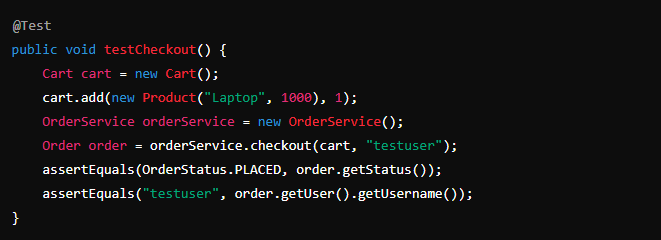Unit testing verifies an app’s individual components or units of code in isolation. The main goal of unit testing is to validate that each unit of the app performs as expected. Developers typically perform this testing during the coding phase, ensuring that each function, method, or class works correctly on its own.
Unit tests are the base of the software testing pyramid, a framework that guides developers in implementing a balanced testing strategy. Acting as the base, unit tests make up the largest portion of the testing pyramid and focus on the smallest components of the codebase.
Types of Unit Tests

Unit tests can be classified into two categories:
- White-Box Testing: Involves testing an app’s internal structures as opposed to its functionality. White-box testing requires knowledge of the code and its implementation.
- Black-Box Testing: Focuses on the app code functionality without looking at the internal code structure. The tester provides input and examines the output without knowing how the code processes the input.
Why Perform Unit Testing?
- Early Bug Detection: Unit tests help identify bugs at an early stage, making them easier and cheaper to fix.
- Code Reliability: Unit testing ensures that individual parts of the app work as intended, increasing overall code reliability.
- Simplifies Integration: By verifying that each unit works correctly in isolation, unit testing simplifies the process of integrating these units into the larger system.
- Facilitates Changes and Refactoring: Unit tests provide a safety net that allows developers to refactor code without fear of introducing new bugs.
- Improves Design: Writing unit tests forces developers to think through the design and logic of their code, often leading to better-structured and more maintainable code.
Challenges and Solutions in Unit Testing
- Time-Consuming: Writing unit tests can be time-consuming. However, the time spent is often offset by the time saved in debugging and maintenance.
- Maintenance: Unit tests need to be maintained as the code evolves. Automated testing frameworks and continuous integration tools can help manage this maintenance.
- Complex Logic: Testing complex logic can be challenging. Breaking down complex functions into smaller, testable units can simplify the testing process.
- Mocking Dependencies: External dependencies (like databases, web services, hardware devices, etc.) can make unit testing difficult. Mocking frameworks (like Mockito for Java or unit test.mock for Python) can help simulate these dependencies.
Best Practices for Unit Testing

Here are some best practices to follow for effective unit testing:
1. Write Independent Tests
Create unit tests that are independent of others to avoid cascading failures and ensure that you can run tests in any order. Avoid sharing state between tests and use setup and teardown methods to initialize and clean up test environments.
2. Use Descriptive Test Names
Clearly describe what the test is verifying in test names. Use a naming convention that includes the method being tested, the scenario under test, and the expected outcome (e.g., calculateSum_PositiveNumbers_ReturnsCorrectSum).
3. Test One Thing at a Time
Verify that each test represents a single piece of functionality or behavior. Write focused tests that have one assertion. If multiple assertions are necessary, ensure they are closely related and test the same functionality.
4. Maintain Test Isolation
Ensure that tests don’t depend on each other or on the external environment. Use mocks and stubs to isolate the unit under test from external dependencies like databases, web services, or hardware.
5. Follow the Arrange-Act-Assert Pattern
Organize tests into three sections: set up the context (Arrange), execute the code under test (Act), and verify the outcome (Assert). This pattern improves readability and helps maintain a clear structure in tests.
6. Write Tests Before Code (TDD)
Test-driven development (TDD) involves writing tests before the actual code. Define the expected behavior through tests and then write code to fulfill those tests. This leads to better design and test coverage.
7. Keep Tests Fast
Ensure unit tests are quick to run to encourage frequent execution. Avoid time-consuming operations such as file I/O or network calls in unit tests. Use in-memory data structures instead.
8. Ensure High Coverage but Focus on Quality
Strive for high code coverage but prioritize meaningful tests overachieving 100% coverage. Aim to cover all critical paths and edge cases but avoid writing tests that add no real value.
9. Mock External Dependencies
Use mocking frameworks to simulate external dependencies and control their behavior. Frameworks like Mockito (Java), unittest.mock (Python), and Sinon.js (JavaScript) can help create reliable and predictable test environments.
10. Review and Refactor Tests Regularly
Review and rector test code for clarity and efficiency. Conduct code reviews for test cases and refactor them to remove redundancies and improve readability.
Examples of Unit Testing
Let’s say you’re performing unit testing on an e-commerce app. Here are some examples of how you can apply unit testing:
Product Search Functionality
Test case: Ensure that the search function returns relevant products.
Sample code (Java):

Adding Items to Cart
Test case: Verify that adding an item to the cart updates the cart correctly.
Sample code (Python):

Removing Items from Cart
Test case: Ensure that removing an item from the cart updates the cart correctly.
Sample code (Java):

Checkout Process
Test case: Ensure that the checkout process works correctly and updates the order status.
Sample code (Java):

Unit Testing with Sofy’s Scriptless Testing Platform
Sofy offers a powerful scriptless testing platform that simplifies the process of creating and maintaining unit tests. Here’s how Sofy enhances unit testing:
- Scriptless Testing: Sofy’s platform allows QA testers and developers to create unit tests without writing code. This scriptless approach accelerates the testing process and makes it accessible to non-developers.
- Real Device Testing: Sofy provides access to a cloud-based real device lab, allowing tests to run on over 100 actual iOS and Android devices rather than emulators or simulators. This ensures more accurate and reliable test results.
- Automation: Automated test execution with Sofy saves time and reduces manual effort, ensuring that tests are run consistently and frequently.
- Integration with CI/CD: Sofy seamlessly integrates with continuous integration and continuous deployment (CI/CD) pipelines, enabling automated unit tests to run with every code change. This ensures that issues are detected and addressed promptly.
- Comprehensive Reporting: Sofy offers detailed reports and analytics, helping teams understand test results, identify issues, and track progress over time.
Want to see Sofy’s scriptless platform in action? Request a demo to see how you can streamline and improve unit testing today!
Final Thoughts on Mastering Unit Testing in Mobile App Development
Unit testing is a fundamental practice in mobile app development that ensures code quality, reliability, and maintainability. Unit testing plays a crucial role in delivering high-quality mobile apps by identifying and fixing bugs early, facilitating safe code refactoring, and improving overall design.
With tools like Sofy’s scriptless testing platform, the process of unit testing becomes more efficient and less burdensome, allowing QA testers and developers to focus on what they do best: building exceptional apps. Whether you are developing for iOS or Android, incorporating robust unit testing practices will help ensure your app is reliable, performant, and ready for users.









